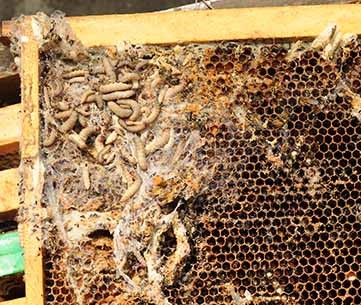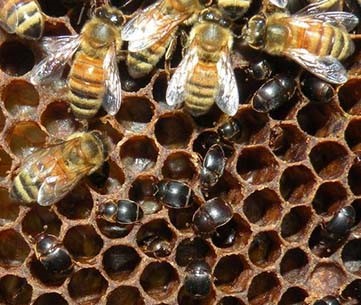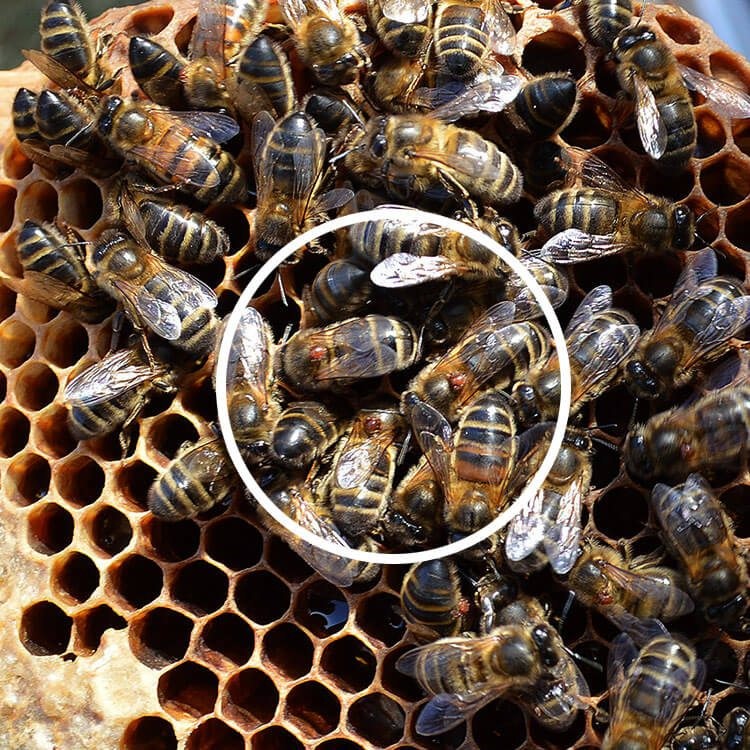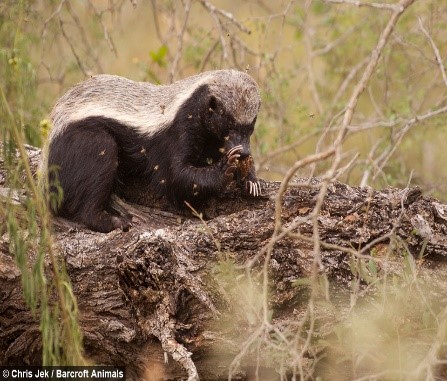4.1. Insect and Pest control
4.1.1. Wax Moth (Galleria mellonella)
- This is the most serious pest on honey bee colonies.
 It is a small brown moth which normally attacks weak colonies where there are unguarded combs.
It is a small brown moth which normally attacks weak colonies where there are unguarded combs.- Weak colonies are characterized by few number of bees usually because of inadequate feeding.
 Control is by making sure the colonies are strong with proper feeding, that is, with sugar syrup during the time of food shortage and leaving enough honey for the bees to feed on when harvesting.
Control is by making sure the colonies are strong with proper feeding, that is, with sugar syrup during the time of food shortage and leaving enough honey for the bees to feed on when harvesting.- This will ensure that all combs are well guarded.
4.1.2. Beetles (Aethina tumida)
 Beetles vary in color and size.
Beetles vary in color and size.- They damage the colonies by feeding on the stored pollen. The greatest damage is done in weak colonies where the beetle will breed and the larvae allowed to burrow through the comb.
 Control is by reducing the entrance holes of the hive to 1 cm diameter.
Control is by reducing the entrance holes of the hive to 1 cm diameter.
4.1.3. Ants (Iridomyrmex humilis)
- These are a common pest of bee colonies in the country.
- Ants attack the brood (eggs, larvae and pupae) and not the honey. Ants usually overwhelm the colony by their numbers causing the bees to leave the hive.
- Control is by applying oil or grease to hive stands or wire supports so that ants have no access to the hive.
4.1.4. Bee lice (Braula spp.)
- It is occasionally seen clinging to the body of the queen bee.
- It eats some food from the mouth parts of its host.
- Control is by putting a heavily infested queen bee in a match box and blowing in tobacco smoke. The bee lice will fall off then the queen bee can be returned to her colony.
4.1.5. The Honey Badger or Ratel (Mellivora capensis) (chiuli)
- This is a destructive animal about 1 m long with very tough skin and long strong curved claws.
- It breaks up bee hives and feeds on all combs without being worried by stings, it can also attack human beings.
- Constructing a fence around the apiary so that it has no access to the hive can control the Honey Badger. Where wires suspend hives, pile thorns on bottom of trees supporting the hive.
- You can also ensure that hives are suspended at a height slightly above a meter. This will disable the honey badger reaching the hive.
- Honey badger is capable of climbing trees and can jump onto the hive from tree branches. Hence, where this animal is a problem, avoid branches hanging over the hive.
4.2. DISEASE AND DISESASE CONTROL
4.2.1. European foul brood
- European foul brood is a disease caused by bacteria causing death of larvae, decay and stench in the hive.
- The disease commonly occurs in the rainy season and most colonies recover by the end of the rainy season.
- European foul brood can be managed by removing all affected combs and by isolating the queen in a queen cage in the hive for up to 10 days to allow workers to clean the hive and release her afterwards.
4.2.2. American foul brood
- American foul brood is caused by spore-forming bacteria and infects larvae that is about 3 days old or less, causing them to die.
- The dead larvae decays and produces a glue-like smell. American foul brood can be managed by burning the colony, combs and frames, disinfection of beehives and by restricting supplementation by using honey and by not exchanging frames, bars and hives from other apiaries.
4.2.3. Sac brood
- This is a viral disease similar in many respects to European foul brood, but it does not produce a foul smell.
- The larvae die in the early stages leaving a watery sac at the bottom of the cells which turns into leather-like scales.
- The sac brood can be managed in a similar way as the European foul brood.
 It is a small brown moth which normally attacks weak colonies where there are unguarded combs.
It is a small brown moth which normally attacks weak colonies where there are unguarded combs. Control is by making sure the colonies are strong with proper feeding, that is, with sugar syrup during the time of food shortage and leaving enough honey for the bees to feed on when harvesting.
Control is by making sure the colonies are strong with proper feeding, that is, with sugar syrup during the time of food shortage and leaving enough honey for the bees to feed on when harvesting. Beetles vary in color and size.
Beetles vary in color and size. Control is by reducing the entrance holes of the hive to 1 cm diameter.
Control is by reducing the entrance holes of the hive to 1 cm diameter.